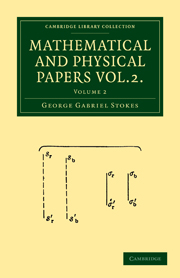Book contents
- Frontmatter
- Contents
- Notes on Hydrodynamics. III. On the Dynamical Equations
- On the constitution of the Luminiferous Ether
- On the Theory of certain Bands seen in the Spectrum
- Notes on Hydrodynamics. IV. Demonstration of a Fundamental Theorem
- On a difficulty in the Theory of Sound
- On the Formation of the Central Spot of Newton's Rings beyond the Critical Angle
- On some points in the Received Theory of Sound
- On the perfect Blackness of the Central Spot in Newton's Rings, and on the Verification of Fresnel's Formula for the intensities of Reflected and Reflacted Rays
- On Attractions, and on Clairaut's Theorem
- On the Variation of Gravity at the Surface of the Earth
- On a Mode of Measuring the Astigmatism of a Defective Eye
- On the Determination of the Wave Length corresponding with any Point of the Spectrum
- Discussion of a Differential Equation relating to the Breaking of Railway Bridges
- Notes on Hydrodynamics, VI. On Waves
- On the Dynamical Theory of Diffraction
- On the Numerical Calculation of a class of Definite Integrals and Infinite Series
- On the Mode of Disappearance of Newton's Rings in passing the Angle of Total Internal Reflection
- On Metallic Reflection
- On a Fictitious Displacement of Fringes of Interference
- On Haidinger's Brushes
- Index
On the Mode of Disappearance of Newton's Rings in passing the Angle of Total Internal Reflection
Published online by Cambridge University Press: 07 September 2010
- Frontmatter
- Contents
- Notes on Hydrodynamics. III. On the Dynamical Equations
- On the constitution of the Luminiferous Ether
- On the Theory of certain Bands seen in the Spectrum
- Notes on Hydrodynamics. IV. Demonstration of a Fundamental Theorem
- On a difficulty in the Theory of Sound
- On the Formation of the Central Spot of Newton's Rings beyond the Critical Angle
- On some points in the Received Theory of Sound
- On the perfect Blackness of the Central Spot in Newton's Rings, and on the Verification of Fresnel's Formula for the intensities of Reflected and Reflacted Rays
- On Attractions, and on Clairaut's Theorem
- On the Variation of Gravity at the Surface of the Earth
- On a Mode of Measuring the Astigmatism of a Defective Eye
- On the Determination of the Wave Length corresponding with any Point of the Spectrum
- Discussion of a Differential Equation relating to the Breaking of Railway Bridges
- Notes on Hydrodynamics, VI. On Waves
- On the Dynamical Theory of Diffraction
- On the Numerical Calculation of a class of Definite Integrals and Infinite Series
- On the Mode of Disappearance of Newton's Rings in passing the Angle of Total Internal Reflection
- On Metallic Reflection
- On a Fictitious Displacement of Fringes of Interference
- On Haidinger's Brushes
- Index
Summary
When Newton's rings are formed between the under surface of a prism and the upper surface of a lens, there is no difficulty in increasing the angle of incidence so as to pass through the angle of total internal reflexion. When the rings are observed with the naked eye in the ordinary way, they appear to break in the upper part on approaching the angle of total internal reflexion, and pass nearly into semicircles when that angle is reached, the Tipper edges of the semicircles, which are in all cases indistinct, being slightly turned outwards when the curvature of the lens is small.
The cause of the indistinctness will be evident from the following considerations. The order of the ring (a term here used to denote a number not necessarily integral) to which a ray reflected at a given obliquity from a given point of the thin plate of air belongs, depends partly on the obliquity and partly on the thickness of the plate at that point. When the angle of incidence is small, or even moderately large, the rings would not be seen, or at most would be seen very indistinctly, if the glasses were held near the eye, and the eye were adapted to distinct vision of distant objects, because in that case the rays brought to a focus at a given point of the retina would correspond to a pencil reflected at a given obliquity from an area of the plate of air, the size of which would correspond to the pupil of the eye; and the order of the rays reflected from this area would vary so much in passing from the point of contact outwards that the rings would be altogether confused.
- Type
- Chapter
- Information
- Mathematical and Physical Papers , pp. 358 - 359Publisher: Cambridge University PressPrint publication year: 2009First published in: 1883



